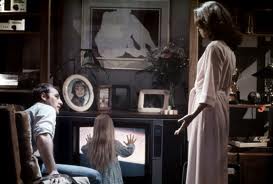Posted by Sarah
All are welcome to attend the fifth of this term’s screening and discussion sessions which will take place on the 13th of November in Keynes Seminar Room 6, from 4pm to 7pm.
We will be screening Frances’ selection: episodes of Twin Peaks and The X Files.
Frances’ introduction:
Twin Peaks and The X-Files
The aim of this week’s session is to continue the discussion inspired by Kat’s screening last week of American Horror Story. As highlighted last week, Kat and I are interested in exploring further the relationship between horror and melodrama, and how this has a particular relevance to television, where such productions are based on the serial format. This week I shall be showing episodes from Twin Peaks and The X-Files as further examples of popular TV shows combining horror and melodrama traditions. Both shows were created and first aired during the 1990s and, as such, represent the forerunners to American Horror Story and the commercialisation of horror as a successful, primetime television component we discussed last week. This week’s session shall therefore look at examples from both series and their spin-offs, including:
– A clip from Twin Peaks: Fire Walk With Me (a 1992 film based on the TV series directed by David Lynch; this film was made as a prequel to the TV show).
– Twin Peaks episode 29, season 2 (first aired in the USA on 10th June 1991; this episode is the final one of the series).
– The X-Files episode 2, season 4 Home (first aired in the USA on 11th October 1996).
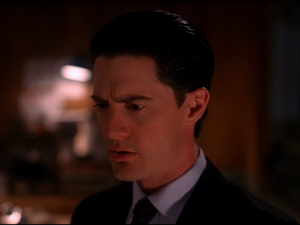 Twin Peaks was first aired in the USA on 8th April 1990 and ended on 10th June 1991, after running for two seasons. The series begins with the discovery of a girl’s body wrapped in plastic and washed up on a riverbank in a quiet American town called Twin Peaks. The girl is revealed to a local named Laura Palmer, a high school student and the school’s prom queen. The news of Laura’s murder shakes the town, particularly as Laura was seen as the perfect, all-American teenage girl with a loving and respectable family. This event sets up the key question which drives the rest of the narrative: who killed Laura Palmer? Soon after the discovery of Laura’s body, another teenager named Ronnette Pulaski is found badly hurt and wandering confused just outside of town. The girl slips into a coma and FBI Agent Dale Cooper is called to investigate Laura’s death and any connection this may have to Ronnette. On inspecting Laura’s corpse, Cooper finds a letter concealed underneath one of her fingernails which bears a striking resemblance to a murder case of another girl murdered a year earlier. Believing the cases to be connected, Cooper remains in Twin Peaks to investigate Laura’s death and expose the killer he thinks may be local or, at least, not very far away.
Twin Peaks was first aired in the USA on 8th April 1990 and ended on 10th June 1991, after running for two seasons. The series begins with the discovery of a girl’s body wrapped in plastic and washed up on a riverbank in a quiet American town called Twin Peaks. The girl is revealed to a local named Laura Palmer, a high school student and the school’s prom queen. The news of Laura’s murder shakes the town, particularly as Laura was seen as the perfect, all-American teenage girl with a loving and respectable family. This event sets up the key question which drives the rest of the narrative: who killed Laura Palmer? Soon after the discovery of Laura’s body, another teenager named Ronnette Pulaski is found badly hurt and wandering confused just outside of town. The girl slips into a coma and FBI Agent Dale Cooper is called to investigate Laura’s death and any connection this may have to Ronnette. On inspecting Laura’s corpse, Cooper finds a letter concealed underneath one of her fingernails which bears a striking resemblance to a murder case of another girl murdered a year earlier. Believing the cases to be connected, Cooper remains in Twin Peaks to investigate Laura’s death and expose the killer he thinks may be local or, at least, not very far away.
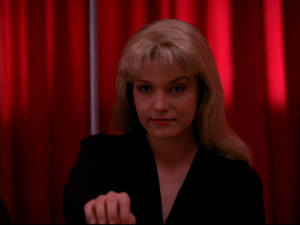 Cooper’s investigation into Laura’s demise is the core plot point which drives the narrative although the FBI agent’s investigations soon expose the corruption and crime which permeates the seemingly sleepy town. The series also follows the lives of all its inhabitants and thus the show features an extensive supporting cast and interweaving sub-plots. Throughout the course of the show, the picturesque Twin Peaks is found to be harbouring drug dealers, pimps, adultery, domestic violence, child abuse, incest, mental illness, blackmailers, corporate corruption, human trafficking, prostitution and, of course, murder. Laura is revealed to be at the heart of these crimes as Cooper discovers two sides to Laura’s life: on the one side, the happy high school girl who was the prom queen and dates a local boy Bobby; on the other side, Cooper discovers Laura’s darker life, where she is also seeing another teenage boy James, is addicted to cocaine and prostitutes herself to pay for her habit, and has been the victim of sexual abuse since childhood. The revelation of Laura’s suffering exposes the perpetrators of these criminals as Twin Peaks locals, as well as illuminating the family dramas of other residents, not directly responsible for Laura’s death. As such the series plays out like a soap opera, where the personal melodramas of the town’s inhabitants becomes public knowledge and the repercussions of this are great: Twin Peaks cannot return to its (however illusory) status as a normal, quiet American town.
Cooper’s investigation into Laura’s demise is the core plot point which drives the narrative although the FBI agent’s investigations soon expose the corruption and crime which permeates the seemingly sleepy town. The series also follows the lives of all its inhabitants and thus the show features an extensive supporting cast and interweaving sub-plots. Throughout the course of the show, the picturesque Twin Peaks is found to be harbouring drug dealers, pimps, adultery, domestic violence, child abuse, incest, mental illness, blackmailers, corporate corruption, human trafficking, prostitution and, of course, murder. Laura is revealed to be at the heart of these crimes as Cooper discovers two sides to Laura’s life: on the one side, the happy high school girl who was the prom queen and dates a local boy Bobby; on the other side, Cooper discovers Laura’s darker life, where she is also seeing another teenage boy James, is addicted to cocaine and prostitutes herself to pay for her habit, and has been the victim of sexual abuse since childhood. The revelation of Laura’s suffering exposes the perpetrators of these criminals as Twin Peaks locals, as well as illuminating the family dramas of other residents, not directly responsible for Laura’s death. As such the series plays out like a soap opera, where the personal melodramas of the town’s inhabitants becomes public knowledge and the repercussions of this are great: Twin Peaks cannot return to its (however illusory) status as a normal, quiet American town.
 Twin Peaks is therefore infused with melodramatic sub-plots and performance, and you will see examples of this in today’s screening. The series is indebted to the features of melodrama we have looked at in previous sessions: the detective story; use of delay and reticence; the threat of the domestic space; heightened emotion and exaggerated performance; and suffering women (there are many suffering women in this series which include but go beyond Laura). However Twin Peaks’s genre is difficult to pin-down precisely, particularly as the series features other surreal moments in true Lynchian fashion: Cooper has many dream sequences where he visits a mysterious red room which is not of this world. Cooper is convinced that this dream holds the clues to solving Laura’s murder and it reveals that the mystery hinges on deciphering who or what is BOB. As a result of this strange mixture – the show’s portrayal of intense family drama juxtaposed with dream sequences and suggestions of the supernatural or mystic which lack narrative or logical explanation – Lenora Ledwon suggests that Twin Peaks is a prime examples of the ‘Television Gothic’. Like the Gothic discussed previously in our sessions, this genre also places an emphasis upon the home, the family, the uncanny and the monstrous (either real or supernatural) but is particularly subversive because of the show’s domesticity as a television programme (Ledwon, 1993, 5). She writes:
Twin Peaks is therefore infused with melodramatic sub-plots and performance, and you will see examples of this in today’s screening. The series is indebted to the features of melodrama we have looked at in previous sessions: the detective story; use of delay and reticence; the threat of the domestic space; heightened emotion and exaggerated performance; and suffering women (there are many suffering women in this series which include but go beyond Laura). However Twin Peaks’s genre is difficult to pin-down precisely, particularly as the series features other surreal moments in true Lynchian fashion: Cooper has many dream sequences where he visits a mysterious red room which is not of this world. Cooper is convinced that this dream holds the clues to solving Laura’s murder and it reveals that the mystery hinges on deciphering who or what is BOB. As a result of this strange mixture – the show’s portrayal of intense family drama juxtaposed with dream sequences and suggestions of the supernatural or mystic which lack narrative or logical explanation – Lenora Ledwon suggests that Twin Peaks is a prime examples of the ‘Television Gothic’. Like the Gothic discussed previously in our sessions, this genre also places an emphasis upon the home, the family, the uncanny and the monstrous (either real or supernatural) but is particularly subversive because of the show’s domesticity as a television programme (Ledwon, 1993, 5). She writes:
This new Television Gothic utilizes familiar Gothic themes and devices such as incest, the grotesque, repetition, interpolated narration, haunted settings, mirrors, doubles, and supernatural occurrences. But these elements undergo a sea change once they are immersed in the “currents” of television. What could have been a soothing repetition of formula instead becomes a disturbing process of transgression and uncertainty. (2)
The extracts from Twin Peaks chosen for you to watch today demonstrate this potent combination of family melodrama, Gothic tropes and horror sequences. Twin Peaks questions the stability and conception of American Dream and in particular the idea of small-town America and the nuclear family. In the clip from Fire Walk With Me this is particularly potent: the seedier sides of Laura’s life become increasingly apparent to the viewer and Laura becomes both a Gothic heroine in her own home – a victim of the evil forces surrounding her – but also an active (and enthusiastic) participant in the town’s sleazy underbelly. The show makes extensive use of horror iconography in these examples and helps to complicate the question: who killed Laura Palmer? On one level this is answered (the killer is revealed mid-way through season two) but the surreal and dreamlike sequences used in the show’s finale show that the answer is not so easy or complete. The series questions whether the evil in the town is inherent in the people who live in Twin Peaks or whether another force is responsible. The show’s final episode also extends this question of instability to another form of authority: the US government. Cooper’s status as an agent of the FBI is an important facet to the murder investigation and, along with other law enforcers like the town’s sheriff, they represent the (only) force of good. Yet the viability of sustaining such control and enforcing the law in Twin Peaks also comes under threat. The series thus ends on an ambiguous note: what is to become of institutions like law enforcement and the family? Does the ending offer any hope? These are questions to keep in mind for the screening.
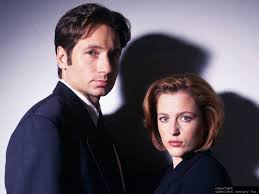 The last episode I am showing is from The X-Files, a series which ran from 10th September 1993 to 19th May 2002, spanning nine seasons. Both The X-Files and Twin Peaks therefore began in the same decade, although the latter was cancelled much earlier. At first glance the two series seem very different: whereas Twin Peaks appears to adopt a soap opera format with an emphasis on the domestic and the family, The X-Files is commonly classified as a science-fiction series and follows the actions of two FBI agents – Mulder and Scully – who investigate a series of cases which feature paranormal occurrences. Mulder is keen prove the existence of aliens although his partner Scully – a scientist who is assigned to evaluate Mulder’s activities – is a hardened sceptic. Over the course of the show, the two agents become very close and learn from each other’s perspectives, as well as investigating cases which reveal criminal activity, paranormal activity and the corruption of the government. For Joe Bellon, the show’s combination of all these elements means that it should not be classified as just ‘science fiction’. (Bellon, 1999). In fact, the show’s strange mixture of not completely conforming to a pro-science perspective but also not being entirely irrational in its representations either, make for a difficult classification. It is for these reasons Bellon argues that The X-Files functions in the ‘ontological detective mode’, where ‘[t]he question to be answered is not “who done it?” but rather “what is it?”’ (7). This shift in emphasis thus widens The X-Files’s concerns beyond the question of the existence of aliens (although very important) and includes the exposure of corruption and evil which wears a very human face, such as the FBI. These larger issues are comparable to the issues raised by the Twin Peaks finale as well.
The last episode I am showing is from The X-Files, a series which ran from 10th September 1993 to 19th May 2002, spanning nine seasons. Both The X-Files and Twin Peaks therefore began in the same decade, although the latter was cancelled much earlier. At first glance the two series seem very different: whereas Twin Peaks appears to adopt a soap opera format with an emphasis on the domestic and the family, The X-Files is commonly classified as a science-fiction series and follows the actions of two FBI agents – Mulder and Scully – who investigate a series of cases which feature paranormal occurrences. Mulder is keen prove the existence of aliens although his partner Scully – a scientist who is assigned to evaluate Mulder’s activities – is a hardened sceptic. Over the course of the show, the two agents become very close and learn from each other’s perspectives, as well as investigating cases which reveal criminal activity, paranormal activity and the corruption of the government. For Joe Bellon, the show’s combination of all these elements means that it should not be classified as just ‘science fiction’. (Bellon, 1999). In fact, the show’s strange mixture of not completely conforming to a pro-science perspective but also not being entirely irrational in its representations either, make for a difficult classification. It is for these reasons Bellon argues that The X-Files functions in the ‘ontological detective mode’, where ‘[t]he question to be answered is not “who done it?” but rather “what is it?”’ (7). This shift in emphasis thus widens The X-Files’s concerns beyond the question of the existence of aliens (although very important) and includes the exposure of corruption and evil which wears a very human face, such as the FBI. These larger issues are comparable to the issues raised by the Twin Peaks finale as well.
The X-Files’s resistance to conforming to the usual conventions of science-fiction does not mean that the show has no discernible genres, however. I would argue that melodrama is an important part of the show, motivating the narrative. Mulder’s preoccupation with all things paranormal is not without cause: he is convinced his sister was abducted by aliens as a child and he is determined to expose the truth. His detective work thus provides the catalyst for the revealing a number of hidden truths along the way, in a manner similar to Cooper’s work in Twin Peaks. Yet the key difference is that Mulder is motivated by his own family trauma: in The X-Files the detective work is a very personal affair. The melodramatic potential of this sub-plot also comes to the fore with another personal relationship, this time the relationship between Mulder and Scully. As the series continues, one of dominant reoccurring stories of the show is the ‘will-they-or-won’t-they?’ question. Although the FBI agents’ relationship is platonic for the majority of the show, the two do become romantically involved.
The X-Files also makes extensive use of horror conventions in its narrative and iconography. The decision to bring horror onto the small screen was quite deliberate: the show’s creator, Chris Carter, mused that there seemed to be a lack of prime-time shows which included horror. He wrote: ‘You look at the TV schedule … and there’s nothing scary on television.’ (quoted in Hammond and Mazdon, 2005, 63). The show’s episodes are therefore littered with monsters, creepy occurrences and unexplained events intended to haunt and disturb. The importance of the horror format is also apparent by the ‘Monster-of-the-Week’ episodes: these are episodes which stand-alone from the main narrative and its concerns (such as Mulder’s sister) but help to develop the evil and horror infecting the larger X-Files universe. It is one of these episodes I have chosen to screen for this session: an episode called Home. In this instalment of the show, The X-Files follows a very similar narrative arc to Twin Peaks: a gruesome discovery in a small, quiet town in American necessitates an investigation by the FBI and Mulder and Scully are sent in. Their investigation leads them to the Peacock family, who live in an old, isolated house and have no contact with the other town’s inhabitants: in fact the family has managed to reproduce through incestuous liaisons. Mulder and Scully attempt to infiltrate this disturbing family home and solve the mystery of the murder.
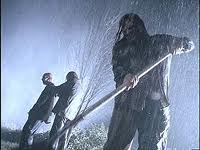 Home became quite an infamous episode for the show, as its horrific content meant that the show was broadcast with a viewer’s warning for the first time in The X-Files’s history. Many reviewers criticised the series for going ‘too far’ in the episode and the network did not re-broadcast the show for many years afterwards. Home has also been rated number one out of the ‘Scariest Science Fiction and Fantasy TV Episode’ with the warning: ‘Once seen, this episode will never leave you.’ (see: http://io9.com/top-25-scariest-science-fiction-and-fantasy-tv-episodes-1450803057). Interestingly, the horror of this episode is unrelated to all of the paranormal investigations which feature elsewhere in the series, and a supernatural explanation for the events does not occur. Rather, like Twin Peaks, Home seeks to expose the horrific living in the domestic sphere, questioning the stability and safety of the traditional family unit. Home presents us with a radical re-definition of the American family which becomes unnatural, perverse and monstrous. One noticeable difference between Home and Twin Peaks is that the first’s family appears to function without any female presence or influence at all: it seems that only three of the Peacock ‘brothers’ live in the old house. However the episode soon subverts expectations again and presents us with extreme variations of the Gothic heroine, as the true nature of the situation comes to light and the investigation is solved. As such The X-Files creates a unique and horrific version of the traditional family melodrama.
Home became quite an infamous episode for the show, as its horrific content meant that the show was broadcast with a viewer’s warning for the first time in The X-Files’s history. Many reviewers criticised the series for going ‘too far’ in the episode and the network did not re-broadcast the show for many years afterwards. Home has also been rated number one out of the ‘Scariest Science Fiction and Fantasy TV Episode’ with the warning: ‘Once seen, this episode will never leave you.’ (see: http://io9.com/top-25-scariest-science-fiction-and-fantasy-tv-episodes-1450803057). Interestingly, the horror of this episode is unrelated to all of the paranormal investigations which feature elsewhere in the series, and a supernatural explanation for the events does not occur. Rather, like Twin Peaks, Home seeks to expose the horrific living in the domestic sphere, questioning the stability and safety of the traditional family unit. Home presents us with a radical re-definition of the American family which becomes unnatural, perverse and monstrous. One noticeable difference between Home and Twin Peaks is that the first’s family appears to function without any female presence or influence at all: it seems that only three of the Peacock ‘brothers’ live in the old house. However the episode soon subverts expectations again and presents us with extreme variations of the Gothic heroine, as the true nature of the situation comes to light and the investigation is solved. As such The X-Files creates a unique and horrific version of the traditional family melodrama.
As with Twin Peaks, this X-Files episode evokes the questions: what is the cause of the ‘evil’ here? How does this reflect upon the idea of family and the domestic home? Can these observations be extended to include the representation of authority, as with the FBI?
Enjoy the shows!
References:
Bellon, J. 1999. ‘The Strange Discourse of The X-Files: What It Is, What It Does, and What Is at Stake.’ Critical Studies in Mass Communication 16, 136-154.
Creeber, G. 2004. Serial Television: Big Drama on the Small Screen. London: British Film Institute.
Hammond, M. and Mazdon, L. (eds.) 2005. The Contemporary Television Series. Edinburgh: Edinburgh University Press.
Kowalski, D. (ed.) 2007. The Philosophy of The X-Files. Kentucky: The University of Kentucky.
Lavery, D., Hague, A. and Cartwright, M. (eds.) 1996. Deny All Knowledge: Reading the X-Files. London: Faber and Faber.
Ledwon, L. 1993. ‘Twin Peaks and the Television Gothic.’ Literature Film Quarterly,21:4, 260-270.
http://io9.com/top-25-scariest-science-fiction-and-fantasy-tv-episodes-1450803057
Do join us if you can, for more TV horror. Visit our additional blog for more information:http://melodramaresearchgroupextra.wordpress.com/



